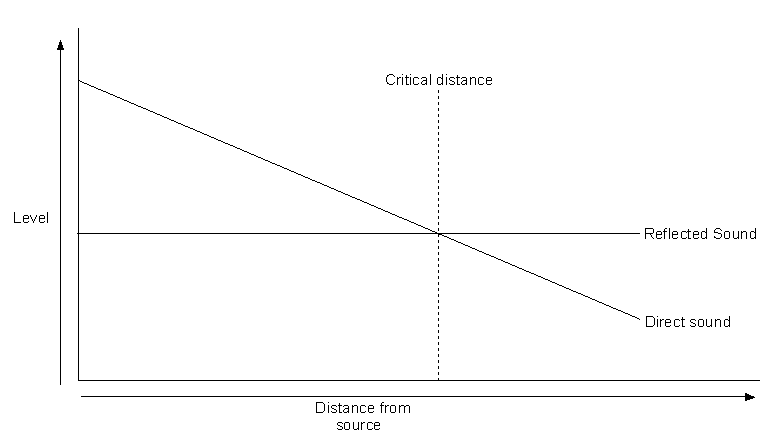Loudspeaker Position in PA SystemsAlthough modern purpose-built venues exist, live music is often played in rooms that were not designed for it. The room is sometimes a major obstacle to good sound, and although a touring band or PA company may not be able to do much about the room itself, substantial improvements in sound can sometimes be achieved by optimal speaker placement. Any sound in an acoustically reflective space (all rooms - barring anechoic chambers - are acoustically reflective spaces) will also produce a certain amount of reflected sound. The level, frequency and duration of reflections will be determined by the surfaces, size and shape of the actual room involved. While the level of an initial sound will be affected by a listener's distance from it (reducing by 6dB for every doubling of distance), the level of reflected sound in a room is relatively constant throughout the room. The graph below illustrates this effect.
While the initial sound may be coherent, reflected sound is affected both by the properties of reflective surfaces (not all frequencies are reflected equally), and by destructive interference (resulting from multiple reflections of the initial sound). Thus reflected sound is generally much less coherent. The point at which reflected sound is equal in level to the direct sound is known as the critical distance. Beyond the critical distance, intelligibility is invariably poor. In choosing and placing speakers, our aims are: 1. Keep reflected sound to a minimum (keep it off the walls and other surfaces). By reducing the level of reflected sound, we increase the critical distance, and add to the area in which the original sound is intelligible. 2. Get as much direct sound to the audience as possible. Speakers should be placed so that any audience member has a direct sight line to a speaker. 3. Get the level and tone as constant as possible throughout the audience. Both overall level and frequency content can affect intelligibility. We don't want the lead vocalist uncomfortably loud near the stage and impossible to hear or understand near the back wall. 4. Keep direct and reflected sound away from microphones. If you don't, you make your system more prone to feedback. |
